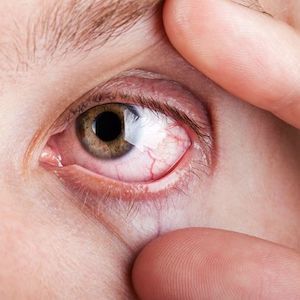Article
Eyelid Squeezing, Rubbing Linked to IOP Increases in Patients with Glaucoma
Author(s):
The eyelid maneuvers increased intraocular pressure by ≥40mm Hg in patients with primary open-angle glaucoma.

A recent study observed eyelid maneuvers in patients with primary open-angle glaucoma (POAG) prompted brief increases in intraocular pressure (IOP).
The findings suggest eyelid squeezing and moderate eyelid rubbing led to temporary increases above 40 mm Hg in IOP, with increases of 12 mm Hg observed for voluntary blinking and 4 mm Hg for eyelid closure, followed by sustained decrease.
“Interestingly, the more prominent fluctuation peaks while patients were awake, were associated with faster visual field progression in patients with POAG,” wrote study author Lars Choritz, Ophthalmology, Otto van Guericke Universitat Magdeburg. “Hence, it might be of importance to advise patients with glaucoma to avoid eyelid squeezing and rubbing.”
There is currently limited data on short-term IOP fluctuations during eyelid maneuvers or its relevance to glaucoma. Recent research on telemetric measurements with the help of a contact lens sensor (CLS) showed distinct IOP spikes during blinking, but it may not fully reflect increases, according to the investigators.
Thus, Chroritz and colleagues investigated IOP fluctuations during eyelid blinking, careful eyelid closure, eyelid squeezing, and eyelid rubbing using a novel telemetric implantable IOP sensor in patients with POAG.
The included participants were a subset of 22 patients with POAG originally implanted with the sensor during the ARGOS-02 study ≥3 years ago. Half of the patients were both willing and able to participate in the current study. They were required to be between the ages of 50 - 85 years and have a functional Eyemate-IO sensor.
The patients were required to return gaze to the primary position for one minute as a baseline measurement, followed by 6 repeats of blinking on instruction with a 10 second interval in-between, according to investigators. Then, 5 repeats of eyelid closure, eyelid squeezing, and eyelid rubbing were performed with 15 second intervals in-between.
For each patient, IOP was recorded via an external antenna placed around the study eye. Investigators analyzed average peak IOP increases from baseline and measured them against zero with one-sample t-tests.
The findings show the average peak IOP increase was 59.1 ± 9.6 mm Hg (P < .001) from baseline for eyelid rubbing. For eyelid squeezing, the average peak IOP was 42.2 ± 5.8 mm Hg (P < .0001) and for eyelid closure, the average initial peak was 3.8 ± 0.6 mm Hg (P <.01) followed by the previously reported decrease in IOP.
Further, the average peak IOP was 11.6 ± 2.4 mm Hg (P <.001) for instructed blinking. Investigators observed no IOP change for involuntary blinking, except for irregularities in the ocular pulse.
The findings on the short-term pressure fluctuations during eyelid maneuvers may potentially implicate the progression of glaucoma and further investigators into these data may be warranted, according to Choritz.
The study, “Effect of eyelid muscle action and rubbing on telemetrically obtained intraocular pressure in patients with glaucoma with an IOP sensor implant,” was published in the British Journal of Ophthalmology.





